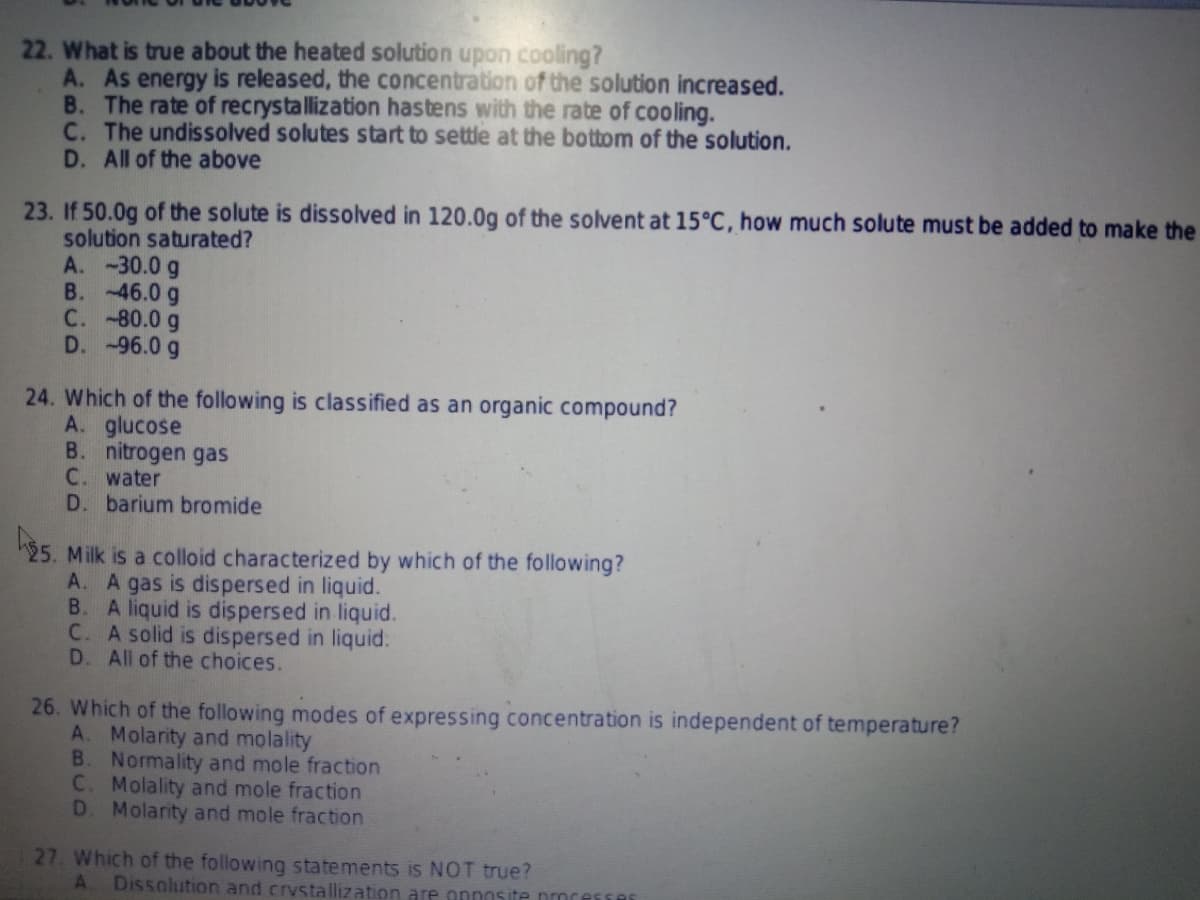What is true about the heated solution upon cooling? A. As energy is released, the concentration of the solution increased. B. The rate of recrystallization hastens with the rate of cooling. C. The undissolved solutes start to settle at the bottom of the solution. D. All of the above
What is true about the heated solution upon cooling? A. As energy is released, the concentration of the solution increased. B. The rate of recrystallization hastens with the rate of cooling. C. The undissolved solutes start to settle at the bottom of the solution. D. All of the above
Chapter80: Crystallization: Purification Of Solids
Section: Chapter Questions
Problem 1P
Related questions
Question

Transcribed Image Text:22. What is true about the heated solution upon cooling?
A. As energy is released, the concentration of the solution increased.
B. The rate of recrystallization hastens with the rate of cooling.
C. The undissolved solutes start to settle at the bottom of the solution.
D. All of the above
23. If 50.0g of the solute is dissolved in 120.0g of the solvent at 15°C, how much solute must be added to make the
solution saturated?
A. -30.0 g
B. -46.0 g
C. -80.0 g
D. -96.0 g
24. Which of the following is classified as an organic compound?
A. glucose
B. nitrogen gas
C. water
D. barium bromide
25. Milk is a colloid characterized by which of the following?
A. A gas is dispersed in liquid.
B.
A liquid is dispersed in liquid.
C. A solid is dispersed in liquid:
D. All of the choices.
26. Which of the following modes of expressing concentration is independent of temperature?
A. Molarity and molality
B. Normality and mole fraction
C. Molality and mole fraction
D. Molarity and mole fraction
27. Which of the following statements is NOT true?
A. Dissolution and crystallization are onnosite nocesse
Expert Solution
This question has been solved!
Explore an expertly crafted, step-by-step solution for a thorough understanding of key concepts.
Step by step
Solved in 2 steps with 1 images

Knowledge Booster
Learn more about
Need a deep-dive on the concept behind this application? Look no further. Learn more about this topic, chemistry and related others by exploring similar questions and additional content below.Recommended textbooks for you

EBK A SMALL SCALE APPROACH TO ORGANIC L
Chemistry
ISBN:
9781305446021
Author:
Lampman
Publisher:
CENGAGE LEARNING - CONSIGNMENT

General Chemistry - Standalone book (MindTap Cour…
Chemistry
ISBN:
9781305580343
Author:
Steven D. Gammon, Ebbing, Darrell Ebbing, Steven D., Darrell; Gammon, Darrell Ebbing; Steven D. Gammon, Darrell D.; Gammon, Ebbing; Steven D. Gammon; Darrell
Publisher:
Cengage Learning

Chemistry: The Molecular Science
Chemistry
ISBN:
9781285199047
Author:
John W. Moore, Conrad L. Stanitski
Publisher:
Cengage Learning

EBK A SMALL SCALE APPROACH TO ORGANIC L
Chemistry
ISBN:
9781305446021
Author:
Lampman
Publisher:
CENGAGE LEARNING - CONSIGNMENT

General Chemistry - Standalone book (MindTap Cour…
Chemistry
ISBN:
9781305580343
Author:
Steven D. Gammon, Ebbing, Darrell Ebbing, Steven D., Darrell; Gammon, Darrell Ebbing; Steven D. Gammon, Darrell D.; Gammon, Ebbing; Steven D. Gammon; Darrell
Publisher:
Cengage Learning

Chemistry: The Molecular Science
Chemistry
ISBN:
9781285199047
Author:
John W. Moore, Conrad L. Stanitski
Publisher:
Cengage Learning

Chemistry: Principles and Practice
Chemistry
ISBN:
9780534420123
Author:
Daniel L. Reger, Scott R. Goode, David W. Ball, Edward Mercer
Publisher:
Cengage Learning

World of Chemistry, 3rd edition
Chemistry
ISBN:
9781133109655
Author:
Steven S. Zumdahl, Susan L. Zumdahl, Donald J. DeCoste
Publisher:
Brooks / Cole / Cengage Learning
